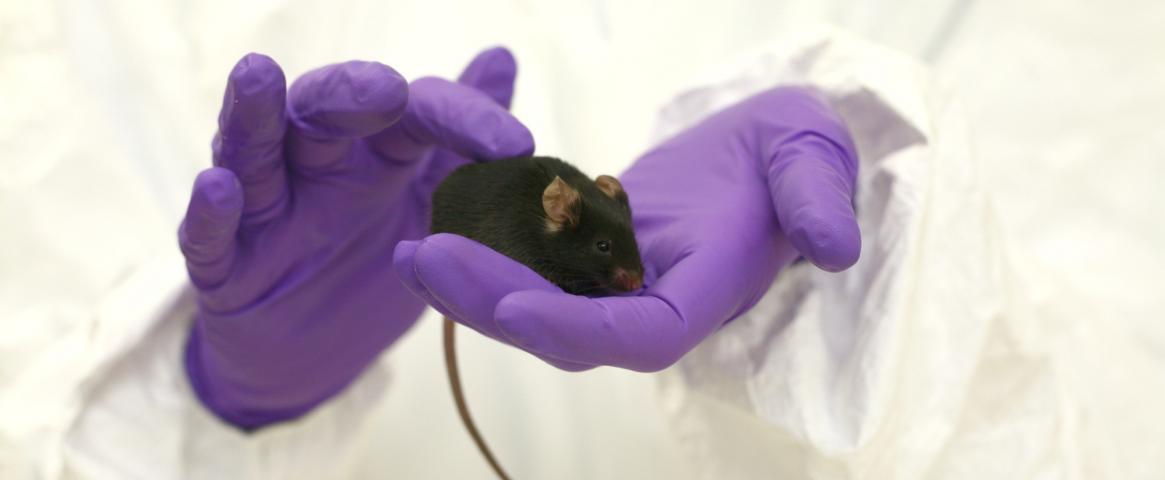By Taylor Engdahl
New research published in Nature presents an innovative approach to combatting emerging variants of SARS-CoV-2, the virus that causes COVID-19. The technique relies on a new type of laboratory mouse, called a "nanomouse," plus a bit of help from llamas. This approach has the potential to advance treatments for a wide range of diseases.
"The strategy of using nanomice is not restricted to SARS-CoV-2 or even just…disease-causing viruses," says Dr. Jianliang Xu, a research fellow at the National Institute of Arthritis and Musculoskeletal and Skin Diseases (NIAMS) and co-first author on the manuscript. "It can even be used for cancer research."
Humans (and mice) produce Y-shaped proteins called antibodies that recognize and fight foreign invaders, like SARS-CoV-2. In addition to their natural, disease-fighting function, antibodies have broad applications in biomedicine, from basic science research to treating patients with cancer or autoimmune diseases.
The drawback of antibodies is that these large molecules are difficult to manufacture and even harder to deliver to patients. Instead, in the new study, the researchers focused on creating a protein with the useful properties of an antibody, but in a smaller, more manageable size. This miniature antibody is called a nanobody.
Due to their small size, nanobodies are exceptionally stable, relatively easy to produce in large quantities, and simple to administer to patients – attractive qualities for biomedical applications. The FDA approved the first nanobodies in 2019 to treat a rare clotting disorder, paving the way for their use as potential therapies for other diseases.
Scientists typically isolate nanobodies from camelids, such as llamas, alpacas, and camels, but these animals are difficult to work with simply because they're too large to fit in an academic laboratory. So, Xu and his colleagues found a way to take the molecular components that camelids use to make nanobodies and package them into the body of a mouse, what they call a "nanomouse." Developing an easier way to produce nanobodies – using nanomice instead of llamas – allows scientists to apply this technology to various diseases, including COVID-19.
When the COVID-19 pandemic began, the researchers – led by Rafael Casellas at NIAMS and Peter Kwong at the National Institute of Allergy and Infectious Diseases – knew it was time to put the nanomouse to the test. In the Nature study, the scientists trained the nanomouse's immune system to produce nanobodies against a particular part of the SARS-CoV-2, namely the spike protein. The virus uses the spike to grab onto and enter human cells. If the nanobodies can block the spike, as the scientists hope, the miniature antibodies may provide protection from COVID-19.
The researchers had reason to be optimistic about their approach. The mouse-derived nanobodies can fit into small groves in the viral spike protein that aren't typically accessible to human antibodies. Because of this, the mini molecules attack the virus from a different angle, giving them an upper hand over our natural antibodies in preventing SARS-CoV-2 infection.
Another advantage of these compact antibodies is the ability to link individual nanobodies into long chains. In theory, clusters of nanobodies would be considerably more effective at neutralizing viruses because their long arms could reach out and block the virus from infecting human cells.
With this in mind, the scientists connected two or three nanobodies in tandem in an attempt to increase the potency of the nanobodies against SARS-CoV-2 variants, including Alpha (first identified in the U.K.), Beta (first identified in South Africa), and Gamma (first identified in Brazil). Sure enough, many of the extended nanobodies were up to 100 times more effective than individual nanobodies, rivaling some of the antibody therapies currently approved under Emergency Use Authorization for treating COVID-19. The researchers are now testing the extended nanobodies on the surging Delta variant, and – based on the mutations in this variant – the team is optimistic that it will be vulnerable to the nanobodies.
Although these results are promising, researchers still need to overcome additional hurdles before testing the nanobodies in clinical trials. Because the nanobodies are animal-derived, they must undergo a series of chemical alterations to prevent the human immune system from rejecting them. As an example, another recently developed llama-derived nanobody against coronaviruses, VHH-72 (or XVR011), required extensive engineering before it could be safely tested in people. A clinical trial of XVR011 launched in May and is now recruiting patients.
After testing the nanomouse – and the nanobodies it can produce – on SARS-CoV-2 variants, the researchers hope to expand the applications of their new research tools. In the spirit of Open Science, the team is enthusiastic about sharing the technology with the larger research community, free of charge.
"SARS-CoV-2 was a model for us to demonstrate the power of these animals," says Xu. "Anyone who wants to work on our model and sees it as a good tool for their research can request it from us."
With a promising future ahead for their nanomice, Xu and his colleagues prove that often the best things do come in small packages.
Taylor Engdahl is a Ph.D. student at Vanderbilt University studying virology and immunology. She contributes to the Vanderbilt Institute of Infection, Immunology, and Inflammation science communication publication, Immuknow+, and has written for Nature's Career Column. Follow her on Twitter @tbengdahl or email her at taylor.engdahl@vanderbilt.edu.
This story was produced as part of NASW's David Perlman Summer Mentoring Program, which was launched in 2020 by our Education Committee. Engdahl was mentored by Alisa Z Machalek.
Main image: Mice are commonly used in biomedical research. Credit: Wikimedia Commons/CC BY-SA





